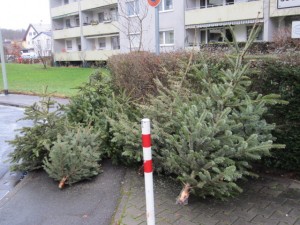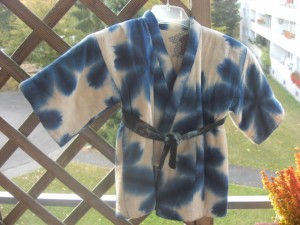The sidewalk is lined with Christmas trees, ready for tomorrow’s collection in Oberursel.

Christmas tree pick up in Germany
Now, where do they go from here…?
There is more information on Recycled German Christmas Trees.
Travel blog
The sidewalk is lined with Christmas trees, ready for tomorrow’s collection in Oberursel.

Christmas tree pick up in Germany
Now, where do they go from here…?
There is more information on Recycled German Christmas Trees.
In English, most Japanese wrap-around clothing is referred to as a kimono. In this case however, this little baby/toddler coat would be appropriately called a yukata (浴衣).

Japanese baby yukata
The interesting part is that it has been made entirely from used cloth diapers. Back in the days, when Japan had not yet been such a throw-away society, the baby’s old diapers got recycled for a practical purpose. After a thourough cleaning, indigo dye was applied to give this lovely tie-dye pattern.
I had read about this technique in one of my Japanese textile history books and got very excited when I actually spotted one in an antique shop (the only tie-dye baby yukata I ever saw in three years of browsing antique shops in Japan).
The price, I believe, was 5000 yen in the early 90s, which equals about € 45 today.
One of the things I brought back from Japan a long time ago was a new perspective on common items.
The first time I saw spaghetti served like a sandwich on a bread roll in Japan, my thoughts went from culinary shock to sheer amazement. I learned then you could take two common items and put them together in a new form, you’ve got an invention.
The one below is not a new one, but it had been for me at that time. I saw the Japanese housewife trimming pretty blossoms off otherwise dead plants and placing them in water in a color contrasting bowl.
This is what I did today with a dead bouquet and an antique Imari bowl brought back from Japan. I enjoyed this part of recycling and recreating.
The Story of Imari: The Symbols and Mysteries of Antique Japanese Porcelain from Amazon.com
The article Living in a world without waste from BBC News is about the Japanese town Kamikatsu which sorts its trash into 34 different categories. The scheme seems to be working well in this small rural town on the island of Shikoku, where residents even combine their trash-dumping trips with shopping to save energy. The town’s mayor went on to say that all residents have to compost their food waste and separate the trash.
Who would have believed the Japanese would ever turn to such drastic measures in recycling? When I lived there 15 years ago, trash was treated as badly as a stray dog. In the little street where I used to live, people just used the whole street as a dumping ground – at least that was my impression back then. Having returned to Japan for the first time in April 2008, I was amazed to see how much more environmentally conscientious the Japanese have become in recycling.
Of course, I think big when it comes to environmental issues as such. It would be great if the Chinese gradually caught on to more recycling measures as well. Three years ago I visited China – there was a non-existent trash awareness in the people, accompanied by a lack of recycling in the country itself.
Personally I might not advocate all of the Kamikatsu’s 34 categories, ten might be sufficient. Nevertheless, a tiny town in Japan has come a long way and this big clean-up act deserves to be called an environmental miracle.

My name is Maria Shipley. I live in Oberursel, Germany with my husband, son and daughter. I … Read more



Copyright © 2024 · Maria Shipley · Datenschutzerklärung · Impressum · Log in
Diese Webseite verwendet Cookies. Wenn Sie auf der Seite weitersurfen, stimmen Sie der Cookie-Nutzung zu. Mehr Informationen
Diese Webseite verwendet so genannte Cookies. Sie dienen dazu, unser Angebot nutzerfreundlicher, effektiver und sicherer zu machen. Cookies sind kleine Textdateien, die auf Ihrem Rechner abgelegt werden und die Ihr Browser speichert. Die meisten der von uns verwendeten Cookies sind so genannte "Session-Cookies". Sie werden nach Ende Ihres Besuchs automatisch gelöscht. Cookies richten auf Ihrem Rechner keinen Schaden an und enthalten keine Viren. Weitere Informationen finden Sie auf der Seite “Datenschutzerklärung”.